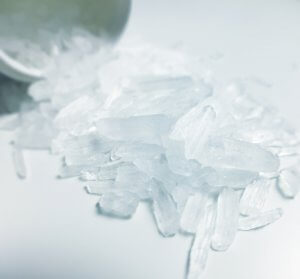What Is Meth Cut With?
Methamphetamine sold on the street often contains various additives and adulterants.
This article will discuss additives found in meth and how to find treatment for meth addiction.

What Is Meth?
Methamphetamine (meth) is a highly addictive stimulant. Meth is listed as a Schedule II controlled substance, meaning it can be prescribed in very low doses as a non-refillable prescription to treat severe attention deficit hyperactivity disorder (ADHD) and other conditions. However, methamphetamine is very rarely prescribed and is primarily an illicit drug that is manufactured in illicit laboratories.1
Meth is commonly sold as a white crystalline powder that is bitter to the taste. Meth can be:1
- Smoked in a pipe.
- Snorted.
- Dissolved in liquid and injected intravenously.
Since there is no regulation of the iliicit meth production process, meth is often “cut” with additives to artificially increase the volume of the drug produced and sold. These additives may also be used to intensify or alter the effects of the drug.2 “Cutting” or “lacing” is a very common tactic to the point that it’s widely accepted by dealers and buyers alike.
Dangerous Additives in Methamphetamine
Many of these additives are dangerous to human health and should not be ingested in any form. Common additives include:3
- Lithium metal
- Hydrochloric acid
- Iodine
- Sulfuric acid
- Red phosphorus
Additives often alter the appearance of the final product, though sometimes it’s impossible to tell by sight that anything has been added to the batch. This can lead to poisoning and meth overdose deaths as someone is likely unaware of what they are putting in their body. At the same time, a batch that contains fewer additives than an individual is used to can cause an overdose.
In recent years, the practice of cutting meth (and other drugs) with fentanyl—a deadly opioid—has become common.2 With this practice gaining popularity, the number of overdoses has also increased.4
Methamphetamine Cut with Fentanyl
Fentanyl is a synthetic opioid that is lethal in very small doses. 50-100 times stronger than morphine, this drug is cheap to produce in illicit labs and may be added to other drugs like meth during or after production to make them appear more potent.5
Drugs containing fentanyl may be visually indistinguishable than those that do not contain the opioid. Carrying Narcan (naloxone) may reduce the risk of a fatal opioid overdose; however, the only way to be completely safe is to avoid using drugs.6
Take Our Substance Abuse Self-Assessment
Take our free, 5-minute substance abuse self-assessment below if you think you or someone you love might be struggling with substance abuse. The evaluation consists of 11 yes or no questions that are intended to be used as an informational tool to assess the severity and probability of a substance use disorder. The test is free, confidential, and no personal information is needed to receive the result.
Increased Health Risks
Mixing meth, or any drug, with other intoxicants compounds health risks to the person using the drug. Mixing stimulants increases the risk of deadly overdose, while combining stimulants like meth with depressants can mask overdose symptoms until it’s too late to get help. Even seemingly harmless additives like powdered milk or baking soda can be harmful if smoked or injected. Certain substances, especially chemicals and metals, can cause serious burns in the mouth and throat, and cause additional irritation in the lungs.
Injecting meth comes with added risks, as many additives can’t be effectively dissolved. As a result, tiny particles end up in the bloodstream and can get stuck, eventually piling up and causing blockages. If this happens around vital organs like the heart, brain, or liver, it can cause dangerous health conditions and even permanent damage or death.
Interestingly, since meth is made using common household cleaners and fertilizers that are often obtained illegally or even stolen, authorities are attempting to curb the problem by inserting their own additives into essential ingredients. Recently, reports came out about such an additive being researched for its potential to be added to anhydrous ammonia – a very common ingredient in meth production. The additive severely reduces the overall yield of the drug, making meth production much less profitable. Fighting the meth industry like this could save the lives of many users and dealers alike.
Getting Help for Meth Addiction
Meth addiction—clinically known as stimulant use disorder—is a treatable condition. Evidence-based approaches employed at rehab centers include behavioral therapy, psychoeducation, peer support, and more.7
Call to speak to a compassionate admissions navigator at American Addiction Centers (AAC). They can walk you through treatment options and help you find a treatment center near you.
You can also verify your insurance coverage for addiction treatment by filling out the confidential form below.
Find Meth Addiction Treatment Near You

